Beth Kanell's Blog, page 20
December 14, 2013
Change Happens: History of The Farmer's Daughter, St. Johnsbury, Vermont
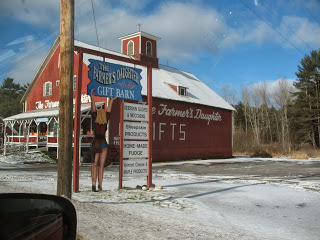
Last year it looked like our region of Vermont had lost, forever, a tourist icon we'd enjoyed for decades: the Route 2 gift shop called The Farmer's Daughter. Jim Young's family had closed the business and although there was a steady trickle of customers for the ongoing stock sale (stuffed moose toys; postcards a bit faded but still capturing memories; Chinese-made coffee mugs that said "Vermont"), the building had an air of sorrow and darkness.
But Anna and Bruce Cushman stepped in to buy the business, and it's been a busy and happy year in the barn -- where the couple and their family offered ice cream and fresh-picked berries, plus live animals (goats, ducks, chickens) to photograph and pet (https://www.facebook.com/pages/The-Farmers-Daughter/370443859742497). Now it's December and they are still resolutely open each weekend until Christmas, despite the bitter cold of the barn in this season. They feature Vermont products, including fudge they make themselves, as well as the work of local crafters.

Anna showed me a page from an old atlas, where the property was featured from way back in the 1800s, and not long after, I found the same page "at auction" online and purchased it. Here's the atlas page:
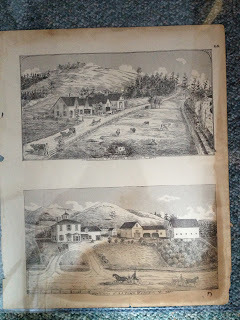
And here's an old photo of the farm in use, brought to Anna by a customer:
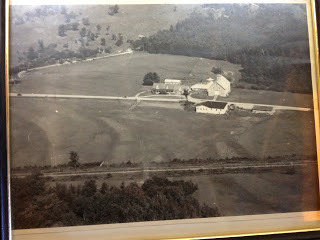
And a map that includes the property:
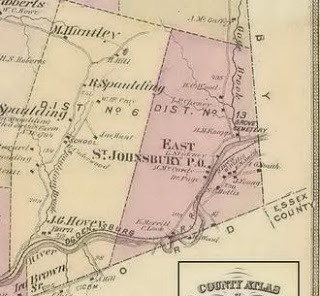
The property owner was J. G. Hovey, and here is an ad from an 1894 church cookbook bearing his name:
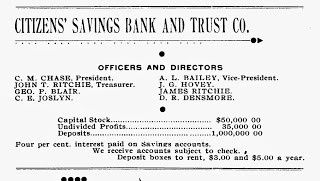
Now -- the Big Question -- why is all this important?
1. It's research: It tells us the reality of both the property that's now the Farmer's Daughter, and the changes that time and commerce bring.
2. It's human: J. G. Hovey as farmer is one thought, as bank director is another. And are there recipes in this cookbook from the women in his life? Women's history before the 21st century is much less documented than men's; this gives us a route into those other documents. Recipes, clothing, family ... the 1800s are rich with artifacts of these.
3. For me, it opens up story possibilities. I'm as interested in Anna's life as current (and shivering!) store owner (take heart, Anna, the days begin to get longer next week, and spring will warm the building again), as I am in the Hoveys, whose history is significant for both St. Johnsbury (did you ever buy clothing at the Hovey Shops?) and Waterford (see the Hovey Place farm: http://waterford-vt-barn-census.blogspot.com/2013/09/hovey-barn-date-unknown-farm-dates-to.html). Will they be background characters in my next novel ... or maybe I'll borrow one of them for a "model" on which to base a protagonist.
Some of the best stories are the real ones. And sometimes it takes a novel to reveal the history underneath.
Published on December 14, 2013 11:20
October 17, 2013
Diversion: Birch Trees and Birch Bark
I have several posts lined up for you (some Chinese-related postcard images; some announcements), but before I get down to serious work on those, I wanted to share this enchanting birchbark "greeting card" sent to a Lyndonville, Vermont, resident in the 1960s. It is part of a collection that arrived at the Lyndon Historical Society this year, shown at the end of the group's meeting on Tuesday Oct. 15.
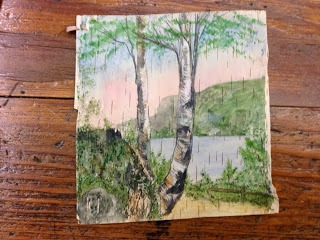
I'm quite sure it's intended to be a scene at Lake Willoughby -- compare it to this actual postcard image dating probably to the 1930s:
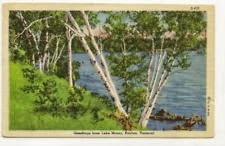

I'm quite sure it's intended to be a scene at Lake Willoughby -- compare it to this actual postcard image dating probably to the 1930s:

Published on October 17, 2013 10:10
August 28, 2013
Explosive Material: The Young Adult Mystery
Did you ever read Tom Sawyer in the original version -- not condensed or modernized? How about Huckleberry Finn? These are now mentioned often as prototype "young adult" novels, along with To Kill a Mockingbird. And the reason they are classified in this way is simple: The characters in them are not yet grown up, and they experience a marked change in their lives: one often described as a loss of innocence.
I think it's important to notice that these labels and even this "loss of innocence" are relatively recent concepts. When I was a kid, the Mark Twain books were seen as accessible (if you were willing to work hard at reading them), but not sorted into "adult" and "young adult." Life on the Mississippi and A Connecticut Yankee in King Arthur's Court could be fit reading for anyone who could stick with the pages -- although clearly, you'd get more from Twain's bouts of satire if you were a more experienced reader.
Today's "young adult" (YA) category is generally recognized as especially the creation of librarians (as well as teachers) who wanted to offer worthwhile material for teens without pushing them into emotions they weren't yet ready to experience -- like the self-doubt that can result from reading sexually explicit material at too young an age, or the callous disregard for loss of life that marks some thrillers. YA material also has often involved recognizing the challenges most teens face: how to stay true to yourself in the face of peer pressure, how to avoid the cost of substance abuse, how to separate from parents without losing "home."
One of the books most recognized as an enduring YA novel is A Wrinkle in Time by Madeleine L'Engle. It shaped some of my ideas about what it is to be a young woman, a scientist, and a brave person. I still keep a copy on my shelf. In her 1983 Newbery Award acceptance speech for this book, the author said:
Even newer than the YA novel is the special genre of the YA mystery. A good one has to include the elements that make a mystery for "grownups" worth reading: a plot that makes sense, twists that are both surprising and believable, characters who risk something and who make choices that matter. And a good dash of suspense and tension! Plus for the YA area, the mystery also has to be what L'Engle called "explosive material." I can stand behind that statement firmly. "Explosive" in this way doesn't need to mean objectionable or even shocking -- but it must mean that the reader experiences a possibility of change and growth.
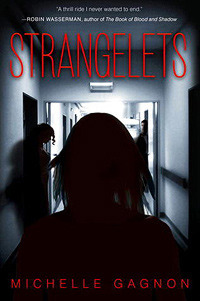 With those challenging aspects in mind, I'm glad to welcome two new YA mysteries to the shelf. One, by Michelle Gagnon, is sci-fi crossover, in which a half dozen teens from various nations find themselves abruptly waking up in an emptied world where dinosaur-size monsters are hunting them. Published by Soho Crime, Gagnon's STRANGELETS compels the teens to share their pasts and wrestle with each other, to discover what has pushed them into this frightening situation -- and whether there is a chance to have their familiar world back again, ever. Criminal activity has indeed taken place. And courage is required. I like Gagnon's earlier thrillers very much, both the adult ones and the YA medical thrillers (Don't Turn Around and Don't Look Now). To me, STRANGELETS pushes the boundaries of the medical thriller, with plenty of intriguing science and tons of suspense. Seventeen-year-olds Sophie and Declan became part of my world while the book lasted. I do think this one is closer to sci-fi than to the traditional medical thriller, but ... it didn't bother me after the first few pages. Above all, Michelle Gagnon is a powerful storyteller and if she wants to call this one a thriller, well, I'll bend a bit.
With those challenging aspects in mind, I'm glad to welcome two new YA mysteries to the shelf. One, by Michelle Gagnon, is sci-fi crossover, in which a half dozen teens from various nations find themselves abruptly waking up in an emptied world where dinosaur-size monsters are hunting them. Published by Soho Crime, Gagnon's STRANGELETS compels the teens to share their pasts and wrestle with each other, to discover what has pushed them into this frightening situation -- and whether there is a chance to have their familiar world back again, ever. Criminal activity has indeed taken place. And courage is required. I like Gagnon's earlier thrillers very much, both the adult ones and the YA medical thrillers (Don't Turn Around and Don't Look Now). To me, STRANGELETS pushes the boundaries of the medical thriller, with plenty of intriguing science and tons of suspense. Seventeen-year-olds Sophie and Declan became part of my world while the book lasted. I do think this one is closer to sci-fi than to the traditional medical thriller, but ... it didn't bother me after the first few pages. Above all, Michelle Gagnon is a powerful storyteller and if she wants to call this one a thriller, well, I'll bend a bit.
The second is a firmly traditional mystery, in a less conventional setting: Jacquelyn Mitchard's WHAT WE SAW AT NIGHT. If the title evokes a hint of The Curious Incident of the Dog in the Night-Time (Mark Haddon), I think that's no accident -- because in Mitchard's book as well as Haddon's, the people we care about are separated from the rest of "us" by conditions of difference that arrived with their genes. In Mitchard's book, Allie Kim and her best friends Rob and Juliet suffer from xeroderma pigmentosum, a "severe allergy to sunlight." (The scientist part of me insists on clarifying: The condition actually means that the body cannot repair damage caused by ultraviolet light. But hey, if we can call alcoholism an allergy to alcohol, I guess the allergy motif works here, too.) The result of this shared disorder is that the three teens mostly emerge at night. Add their fascination with the discipline and daring of parkour -- an extreme sport -- and Allie, Rob, and Juliet take to climbing tall buildings in the dark. Inevitably, they see something criminal. But they're up against a very crafty psychopath with the skills and knowledge to make the teens appear to be the guilty ones. Not only that: It looks like Juliet is being compelled to submit to abuse, with her friends as hostages.
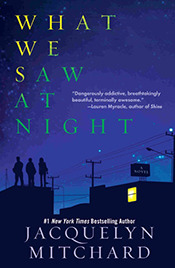 Mitchard demonstrates that the ages of YA protagonists can actually increase the tension and risks of a thriller; the decisions that Allie Kim faces are indeed explosive, stirring up fresh importance of life. I'm glad there's clearly going to be a sequel!
Mitchard demonstrates that the ages of YA protagonists can actually increase the tension and risks of a thriller; the decisions that Allie Kim faces are indeed explosive, stirring up fresh importance of life. I'm glad there's clearly going to be a sequel!
So, let me wrap up this long-ish post by saying: If you have a favorite YA mystery or novel ... is there something about it that's explosive in this way? Share, if you feel so moved.
I think it's important to notice that these labels and even this "loss of innocence" are relatively recent concepts. When I was a kid, the Mark Twain books were seen as accessible (if you were willing to work hard at reading them), but not sorted into "adult" and "young adult." Life on the Mississippi and A Connecticut Yankee in King Arthur's Court could be fit reading for anyone who could stick with the pages -- although clearly, you'd get more from Twain's bouts of satire if you were a more experienced reader.
Today's "young adult" (YA) category is generally recognized as especially the creation of librarians (as well as teachers) who wanted to offer worthwhile material for teens without pushing them into emotions they weren't yet ready to experience -- like the self-doubt that can result from reading sexually explicit material at too young an age, or the callous disregard for loss of life that marks some thrillers. YA material also has often involved recognizing the challenges most teens face: how to stay true to yourself in the face of peer pressure, how to avoid the cost of substance abuse, how to separate from parents without losing "home."
One of the books most recognized as an enduring YA novel is A Wrinkle in Time by Madeleine L'Engle. It shaped some of my ideas about what it is to be a young woman, a scientist, and a brave person. I still keep a copy on my shelf. In her 1983 Newbery Award acceptance speech for this book, the author said:
Because of the very nature of the world as it is today our children receive in school a heavy load of scientific and analytic subjects, so it is in their reading for fun, for pleasure, that they must be guided into creativity.She added, quoting from another author, that we help our children avoid a limited universe "by providing them with 'explosive material capable of stirring up fresh life endlessly.'"
Even newer than the YA novel is the special genre of the YA mystery. A good one has to include the elements that make a mystery for "grownups" worth reading: a plot that makes sense, twists that are both surprising and believable, characters who risk something and who make choices that matter. And a good dash of suspense and tension! Plus for the YA area, the mystery also has to be what L'Engle called "explosive material." I can stand behind that statement firmly. "Explosive" in this way doesn't need to mean objectionable or even shocking -- but it must mean that the reader experiences a possibility of change and growth.
 With those challenging aspects in mind, I'm glad to welcome two new YA mysteries to the shelf. One, by Michelle Gagnon, is sci-fi crossover, in which a half dozen teens from various nations find themselves abruptly waking up in an emptied world where dinosaur-size monsters are hunting them. Published by Soho Crime, Gagnon's STRANGELETS compels the teens to share their pasts and wrestle with each other, to discover what has pushed them into this frightening situation -- and whether there is a chance to have their familiar world back again, ever. Criminal activity has indeed taken place. And courage is required. I like Gagnon's earlier thrillers very much, both the adult ones and the YA medical thrillers (Don't Turn Around and Don't Look Now). To me, STRANGELETS pushes the boundaries of the medical thriller, with plenty of intriguing science and tons of suspense. Seventeen-year-olds Sophie and Declan became part of my world while the book lasted. I do think this one is closer to sci-fi than to the traditional medical thriller, but ... it didn't bother me after the first few pages. Above all, Michelle Gagnon is a powerful storyteller and if she wants to call this one a thriller, well, I'll bend a bit.
With those challenging aspects in mind, I'm glad to welcome two new YA mysteries to the shelf. One, by Michelle Gagnon, is sci-fi crossover, in which a half dozen teens from various nations find themselves abruptly waking up in an emptied world where dinosaur-size monsters are hunting them. Published by Soho Crime, Gagnon's STRANGELETS compels the teens to share their pasts and wrestle with each other, to discover what has pushed them into this frightening situation -- and whether there is a chance to have their familiar world back again, ever. Criminal activity has indeed taken place. And courage is required. I like Gagnon's earlier thrillers very much, both the adult ones and the YA medical thrillers (Don't Turn Around and Don't Look Now). To me, STRANGELETS pushes the boundaries of the medical thriller, with plenty of intriguing science and tons of suspense. Seventeen-year-olds Sophie and Declan became part of my world while the book lasted. I do think this one is closer to sci-fi than to the traditional medical thriller, but ... it didn't bother me after the first few pages. Above all, Michelle Gagnon is a powerful storyteller and if she wants to call this one a thriller, well, I'll bend a bit.The second is a firmly traditional mystery, in a less conventional setting: Jacquelyn Mitchard's WHAT WE SAW AT NIGHT. If the title evokes a hint of The Curious Incident of the Dog in the Night-Time (Mark Haddon), I think that's no accident -- because in Mitchard's book as well as Haddon's, the people we care about are separated from the rest of "us" by conditions of difference that arrived with their genes. In Mitchard's book, Allie Kim and her best friends Rob and Juliet suffer from xeroderma pigmentosum, a "severe allergy to sunlight." (The scientist part of me insists on clarifying: The condition actually means that the body cannot repair damage caused by ultraviolet light. But hey, if we can call alcoholism an allergy to alcohol, I guess the allergy motif works here, too.) The result of this shared disorder is that the three teens mostly emerge at night. Add their fascination with the discipline and daring of parkour -- an extreme sport -- and Allie, Rob, and Juliet take to climbing tall buildings in the dark. Inevitably, they see something criminal. But they're up against a very crafty psychopath with the skills and knowledge to make the teens appear to be the guilty ones. Not only that: It looks like Juliet is being compelled to submit to abuse, with her friends as hostages.
 Mitchard demonstrates that the ages of YA protagonists can actually increase the tension and risks of a thriller; the decisions that Allie Kim faces are indeed explosive, stirring up fresh importance of life. I'm glad there's clearly going to be a sequel!
Mitchard demonstrates that the ages of YA protagonists can actually increase the tension and risks of a thriller; the decisions that Allie Kim faces are indeed explosive, stirring up fresh importance of life. I'm glad there's clearly going to be a sequel!So, let me wrap up this long-ish post by saying: If you have a favorite YA mystery or novel ... is there something about it that's explosive in this way? Share, if you feel so moved.
Published on August 28, 2013 18:20
July 9, 2013
Imagination and Knowledge: Pillars of Good Fiction
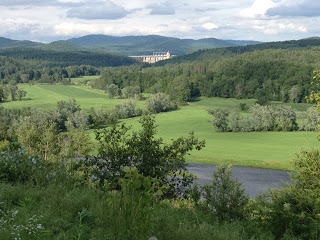 The old adage "write what you know" is very different when applied to historically hinged fiction. There are writing days when every paragraph demands that I stop to double-check details, make sure that an easy assumption actually fits the facts. For Cold Midnight this meant compiling the small details of 1921 life in St. Johnsbury, Vermont, and some careful mapping of 1921's Chinatown layout in Boston as well.
The old adage "write what you know" is very different when applied to historically hinged fiction. There are writing days when every paragraph demands that I stop to double-check details, make sure that an easy assumption actually fits the facts. For Cold Midnight this meant compiling the small details of 1921 life in St. Johnsbury, Vermont, and some careful mapping of 1921's Chinatown layout in Boston as well.The toughest research I've done so far was probably the five years or so leading up to The Darkness Under the Water -- in part because the emotional effects of the Vermont Eugenics Program are far from over, and people who told me about their parents' and grandparents' experience of that time often didn't want to be explicit. For example, it took a long time before someone finally whispered to me the name of a local doctor who might have performed operations in the 1920s on women whom he believed should not bear more children ... long before that whisper, I'd suspected such a presence, but it was important to confirm it.
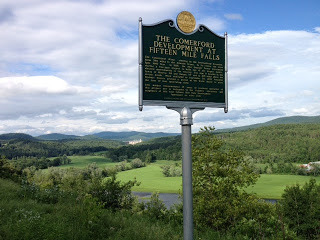
The two photos shown here were taken just a few feet apart. One is the simple (but lush!) scenic view from the rest area on Interstate 91, just north of the Barnet, Vermont, exit. It suggests a forested landscape without many people. The presence of the county seat is well hidden -- along with the dark side of some lives in the region, as well as the thriving movement of technology and information in the towns below.
The second photo carries some details of the history of what's out there: Comerford Dam, so impressive in 1930 that for its first day of operation, the U.S. President triggered the "on" switch; there's even a description of the size of the lake formed behind the dam on the Connecticut River. But the sign doesn't mention one of the most significant aspects of this dam: It was the first on this body of water to NOT have a sluice gate for logs to pass through -- marking the end of the great river logging era in Vermont.
What we know about a landscape shapes what we believe about it. Knowledge nourishes a well-trained writer's imagination!
Published on July 09, 2013 19:55
I Love a Good Mystery/Thriller/Suspense Novel ... and Review Them
Just realized some wonderful readers are looking here for the latest in mystery reviews -- but they are at the OTHER blog (blush ... yeah, I've got a few): kingdombks.blogspot.com
Sorry for the extra jump needed!
Sorry for the extra jump needed!
Published on July 09, 2013 14:48
May 25, 2013
Memorial Day Weekend, Concord, Vermont
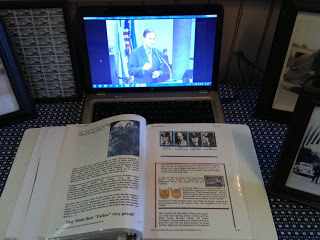 Honoring the Four Chaplains.A few weeks ago, Dave and I took a drive to Gilman, Vermont, a village of many names -- it's a village within the town of Lunenburg and was earlier named Fitzdale, but adopted the surname of the industrialist and philanthropist who changed its history: Isaac "Ike" Gilman. The lone Jew in town, Ike Gilman created employment, funded the church, provided in many ways for enrichment of village life. It's a bigger story than that, but I'm leaving it to Dave to collect the research and do the telling.
Honoring the Four Chaplains.A few weeks ago, Dave and I took a drive to Gilman, Vermont, a village of many names -- it's a village within the town of Lunenburg and was earlier named Fitzdale, but adopted the surname of the industrialist and philanthropist who changed its history: Isaac "Ike" Gilman. The lone Jew in town, Ike Gilman created employment, funded the church, provided in many ways for enrichment of village life. It's a bigger story than that, but I'm leaving it to Dave to collect the research and do the telling.Just before reaching Gilman, we paused in another village, East Concord -- part of Concord, Vermont. Concord has an amazingly rich history, including the first teacher training school in the state (a "normal" school as the label was then), and a home where poet Robert Frost lived for a year or two. Home to many an agricultural enterprise, it also hosted Abenaki (Native American) presence, in part due to its location along the Connecticut River and its lakes and streams.
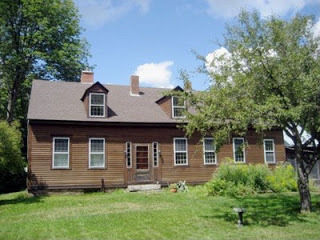 House where Robert Frost lived, Concord Corners.
House where Robert Frost lived, Concord Corners.East Concord has a serene white church building; a park; and a state history marker honoring the Rev. George Lansing Fox, one of the famous "Four Chaplains" whose sacrifice made such an impression during World War II. You can read the story here: http://en.wikipedia.org/wiki/Four_Chaplains
On this Memorial Day weekend, we motored over to the Concord Historical Society to see a special exhibit on Fox and the other three chaplains, including many magazine and newspaper articles, a video, and a state proclamation honoring Fox. It seemed a perfect time for the town to reflect on its homegrown hero, a man who never fired a weapon in the war but whose action saved lives.
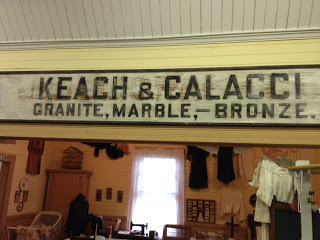 We lingered among the other exhibits, appreciating the town's farm and logging heritage as well as its schools, doctors, and more. What I hadn't realized was the role of stone in Concord, until I saw this lovely old business sign up on the wall for Keach & Calacci -- Granite, Marble, Bronze. In Vermont history, the Italian stonecutters are usually found around Barre, where the Rock of Ages granite quarry continues to provide material for these artists. I knew they had also reached the Northeast Kingdom town of Ryegate, where there were (and still are!) also granite sheds. But I was surprised to find the Calacci family all the way over in Concord, and noted the business in records from 1928, 1930, and 1935 (listed here).
We lingered among the other exhibits, appreciating the town's farm and logging heritage as well as its schools, doctors, and more. What I hadn't realized was the role of stone in Concord, until I saw this lovely old business sign up on the wall for Keach & Calacci -- Granite, Marble, Bronze. In Vermont history, the Italian stonecutters are usually found around Barre, where the Rock of Ages granite quarry continues to provide material for these artists. I knew they had also reached the Northeast Kingdom town of Ryegate, where there were (and still are!) also granite sheds. But I was surprised to find the Calacci family all the way over in Concord, and noted the business in records from 1928, 1930, and 1935 (listed here).Last but not least, here are two posters that are tacked high over one of the doorways at the Concord Historical Society -- the one on the left is the shows at Tegu's Palace, one of the two St. Johnsbury theaters that I wove into my 1930/Waterford "history-mystery," The Darkness Under the Water. What a gem! And the one on the right, I am guessing, belongs with a street sign that I noticed outside East Concord during our road trip: Dance Hall Road. (It runs into Oregon Road -- more on that, another time.)
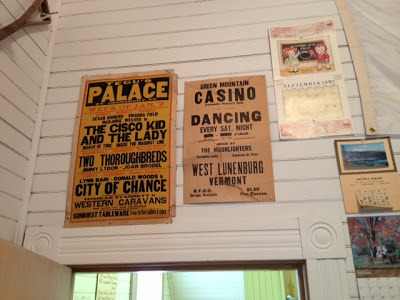 In case it needs saying, what these signs and stories say to me, more clearly than ever, is that hundreds of stories wait to be told, weaving the daily events and places of the past century into the adventures of the people, "real" and fictional, who live and lived in Vermont. I can hardly wait to discover more.
In case it needs saying, what these signs and stories say to me, more clearly than ever, is that hundreds of stories wait to be told, weaving the daily events and places of the past century into the adventures of the people, "real" and fictional, who live and lived in Vermont. I can hardly wait to discover more.
Published on May 25, 2013 16:18
May 10, 2013
The Farmer's Daughter, and Other Adventures with My Mom
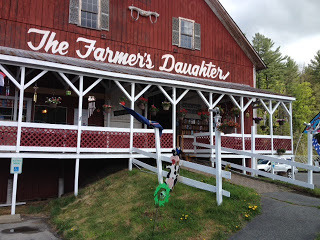 Grand opening this weekend!! What a great new life for a terrific place.My mother wanted to get lost, every time she drove the car out onto a back road. The five of us kids would play games with license plates we saw, or letters on signs, or anything else we could see through the windows -- we all got desperately carsick if we tried to read in the car, or else we would have opened our books. At least for the three older siblings, books were the magical escape into our own private adventures (my two youngest brothers did some things differently).
Grand opening this weekend!! What a great new life for a terrific place.My mother wanted to get lost, every time she drove the car out onto a back road. The five of us kids would play games with license plates we saw, or letters on signs, or anything else we could see through the windows -- we all got desperately carsick if we tried to read in the car, or else we would have opened our books. At least for the three older siblings, books were the magical escape into our own private adventures (my two youngest brothers did some things differently).But on Mom's adventures, the idea was to discover unusual places (like the store on Route 23 in northern New Jersey that sold only buttons -- gallon JARS of buttons for sale!), special waterfalls (hidden ones are best), and places that connected with George Washington, General Lafayette, and "Mad" Anthony Wayne, all easy enough to find in north Jersey, crammed with Revolutionary War battlegrounds. And, incidentally, one "should" get lost.
Unfortunately, Mom's "direction bump," as she called it, kept her from ever getting truly lost. I think that was the biggest regret that she ever expressed around the group of us! Of course, it was also a source of pride and cheerful enjoyment.
When I first drove a car myself through St. Johnsbury, Vermont, and saw the Maple Grove syrup plant and the gift shop called the Farmer's Daughter -- sometime in 1978 -- I had a moment of déja vu. Surely I had been here before? And entered those doors?
I had indeed. Perhaps in 1956 or 1957! I recall the scent of small pillows of balsam needles, and tiny pillars of pine incense one could burn at a campsite to (hopefully) keep away bugs. I remember being barely tall enough to see what was on the shelves.
For a while last year, it looked as though the lifetime of the Farmer's Daughter had ended, and I mourned. Even with that crazy sign out front (the one that makes my Inner Feminist cringe -- I'm not showing it here), I love the place. My mom wouldn't have wanted to see it pass away.
But this spring, oh glorious news, the Cushman family has leased the building and the gift shop business, provided a fresh version of the "fresh" sign outside, added ice cream and homemade fudge (really, they are making it themselves!), and brought back the happy site with fresh paint, baskets of flowers, even a young goat in a neat little barn outside. I am SO happy!
I can feel my mother peeking over my shoulder. She says, "See, we came here when you were little. I love you, honey. Let's get ice cream cones and buy one of those postcards and maybe that jigsaw puzzle in case it rains later. And then we'll get back into the car and get lost. When we've had enough, we'll go back to the campsite and write a poem about this place."
Love you, Mom. Happy Mother's Day of the heart.
(Joan Lancy Palmer Minden, 1927-1981; a New Englander forever, even as she raised us on a mountain in New Jersey.)
Published on May 10, 2013 09:13
May 9, 2013
The Great Gatsby Goes to the Screen: That 1922 Glamour and Risk
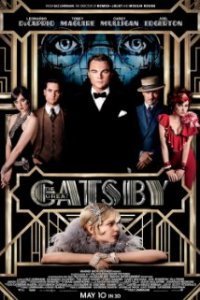 Baz Lurhmann’s adaptation of F. Scott Fitzgerald’s
The Great Gatsby
opens on May 10, and stars Leonardo DiCaprio (as Jay Gatsby), Carey Mulligan (as Daisy Buchanan), and Tobey Maguire (as Nick Carraway). For many moviegoers, there'll be some justified wondering about whether the film's version of the Roaring Twenties is exaggerated -- was there really such a gap between rich and poor, wealthy and hard-scrabble?
Baz Lurhmann’s adaptation of F. Scott Fitzgerald’s
The Great Gatsby
opens on May 10, and stars Leonardo DiCaprio (as Jay Gatsby), Carey Mulligan (as Daisy Buchanan), and Tobey Maguire (as Nick Carraway). For many moviegoers, there'll be some justified wondering about whether the film's version of the Roaring Twenties is exaggerated -- was there really such a gap between rich and poor, wealthy and hard-scrabble?The short answer is: Yes. Although today's wealth gap is wider in terms of dollars, the 1920s showed Americans what that famous American Dream could look like in terms of costly clothing, money enough to eat and drink what and where you wanted, glamour and glitz. Fitzgerald's book is now a researcher's treasure trove, containing not only telling details about life, but also emotional levels that can be explored and used for measuring some points of view as we construct historical fiction dating back to the 1920s.
I kept Fitzgerald, Hemingway, and many newspaper articles on hand while crafting COLD MIDNIGHT. If I could have slept with them under my pillow, I would have! (But the print makes me sneeze.) It especially mattered in terms of the relationship Ben has in the novel with Colonel Bateman, as well as Claire's restricted grasp of her own town -- which had its "high life" way outside her own working-class experience.
I plan to see the film sometime in the next week or so, to enjoy Luhrmann's take on "what it was all like." I can hardly wait!
Published on May 09, 2013 12:53
April 29, 2013
Recovery from the Christmas Fire: More Photos (St. Johnsbury, Vermont)
Fires continue to ravage the Northeast Kingdom of Vermont, to the point where we need our own version of the Three Little Pigs story ... because the buildings have wood frames, even when the outsides are brick or stone, and we continue to be vulnerable. Saturday night a home in Concord, Vermont, was lost; Sunday, oddly, one of the commuter buses burned.
Today Philip C. Marshall (http://www.panoramio.com/photo/18438727?tag=US_VT_St_Johnsbury) generously gave permission for use of his St. Johnsbury photos, and here is one of the 1879 building -- Bruno Ravel's building, where his parents long operated the Landry Drug Store -- before the Christmas 2012 fire struck.
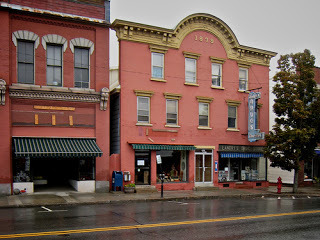 photo by Philip C. Marshall
photo by Philip C. Marshall
And here are some pix that the construction crew allowed me to snap last week: reconstructing the brick frame for the shop windows; the room where the drugstore used to be (see the tin ceiling?); and the back exterior.



Progress indeed ...
Readers of COLD MIDNIGHT: Claire and Ben did not climb this structure (although the author has, from the inside); the Saturday night activities on Railroad Street in 1921 made it far too risky. But it will reappear in the 2014 book I'll be writing, The Fire Curse.
Today Philip C. Marshall (http://www.panoramio.com/photo/18438727?tag=US_VT_St_Johnsbury) generously gave permission for use of his St. Johnsbury photos, and here is one of the 1879 building -- Bruno Ravel's building, where his parents long operated the Landry Drug Store -- before the Christmas 2012 fire struck.
 photo by Philip C. Marshall
photo by Philip C. MarshallAnd here are some pix that the construction crew allowed me to snap last week: reconstructing the brick frame for the shop windows; the room where the drugstore used to be (see the tin ceiling?); and the back exterior.



Progress indeed ...
Readers of COLD MIDNIGHT: Claire and Ben did not climb this structure (although the author has, from the inside); the Saturday night activities on Railroad Street in 1921 made it far too risky. But it will reappear in the 2014 book I'll be writing, The Fire Curse.
Published on April 29, 2013 07:21
April 17, 2013
African Americans in 19th-Century Vermont: Fresh Resources
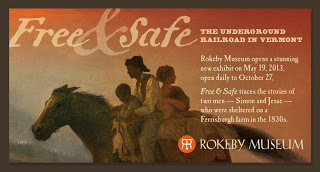 Rokeby's new and exciting exhibit opens May 19, 2013.Rokeby, Vermont's principal verified "Underground Railroad" historic site, will open its new exhibits on May 19, inaugurating the freshly constructed building that the site's team will use for group visits, teaching, and especially making history accessible to young students (say, fourth grade). I'm a fan -- and here's a news interview with director Jane Williamson as the space gets its finishing touches: http://www.wcax.com/story/21390215/a-new-exhibit-at-rokeby-museum
Rokeby's new and exciting exhibit opens May 19, 2013.Rokeby, Vermont's principal verified "Underground Railroad" historic site, will open its new exhibits on May 19, inaugurating the freshly constructed building that the site's team will use for group visits, teaching, and especially making history accessible to young students (say, fourth grade). I'm a fan -- and here's a news interview with director Jane Williamson as the space gets its finishing touches: http://www.wcax.com/story/21390215/a-new-exhibit-at-rokeby-museumWilliamson has quipped that the Vermont version of the decades just before the Civil War should be called the "above-ground" railroad years instead, and her exhibit title is "Free & Safe" -- a good description for Black Americans who arrived in the Green Mountains in the 1830s through 1850s. Elise Guyette's book "Discovering Black Vermont: African-American Farmers in Hinesburgh, Vermont 1790 - 1890" won a 2010 Award of Excellence from the Vermont Historical Society and offers an extensive exploration.
I just realized that there's a phenomenal hour-long presentation by Guyette available on the Net, thanks to Marlboro College: http://www.youtube.com/watch?v=1GCGu0AsDgk -- a great way to catch up on her work and catch some of the flavor of this lively presenter.
If you're teaching or gathering in Vermont and want to check whether a site near you with an Underground Railroad reputation is historically significant, I recommend the State of Vermont report "Friends of Freedom: The Vermont Underground Railroad Survey Report." This 1996 document peels open the evidence for (and against) 174 of the 19th-century individuals and sites that have been mentioned in this context. I still have a few copies available at $15 each (postage included); let me know if you'd like one.
This year Vermont provides a heritage trail to explore the lives and impact of Black Vermonters of the 19th century, too -- as noted in this Burlington Free Press article (I contributed information on the Coventry location). With this comes fresh attention to Alexander Twilight, probably the first mixed-race Vermonter to graduate (in a remarkably short time) from Middlebury College in 1822. There's a good VPR interview on Twilight and his "race" in Vermont's Census records: http://www.vpr.net/episode/55438/groundbreaking-history-alexander-twilight
These are great resources for classroom use and for a break from books and paper, as spring makes the classroom -- or home office! -- seem a bit confined.
PS -- If you're new to this blog: One reason my writing-room reference shelves keep filling with more materials about Vermont's Black residents is my 2011 novel, THE SECRET ROOM. Signed copies are at several Vermont bookstores or you can order them at www.BethKanell.com; video support on this history-mystery set in North Danville, Vermont, can be found here: http://www.thesecretroombook.com/the-author.html
Published on April 17, 2013 15:24



